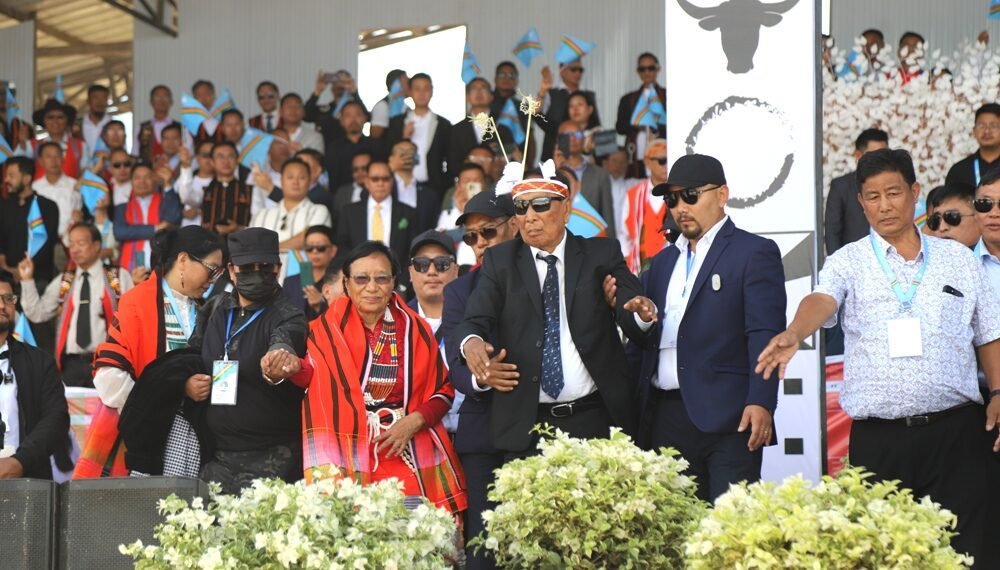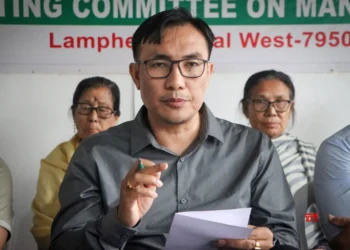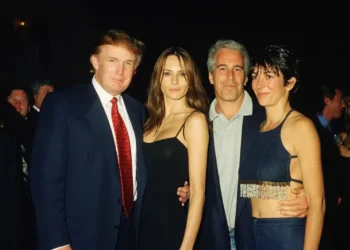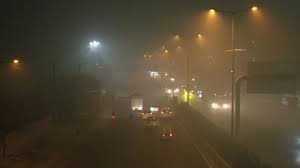Local Hero, National Ghost: While thousands cheer in Ukhrul, Delhi’s newsrooms focus elsewhere, leaving NSCN-Im leader Th. Muivah’s message unheard.
BY Navin Upadhyay
October 24, 2025 — Two days after 91-year-old Thuingaleng Muivah, the grizzled patriarch of the Naga insurgency, returned tearfully to his birthplace in Manipur’s Somdal village after over five decades in exile, the euphoria has swept through the Naga hills like a fleeting monsoon shower.
Thousands in traditional feathered headgear and woven shawls lined dusty roads, chanting “Ato Kilonser” as helicopters ferried the frail NSCN-IM general secretary from his Dimapur camp to Ukhrul and then Somdal on October 22. For locals, it was a historic balm—a symbol of unbroken resolve amid stalled peace talks and ethnic scars.
Yet, as Muivah settles into a week-long stay until October 28, a stark silence has descended from India’s mainstream media. What began as a brief flurry of headlines has evaporated, underscoring the rebel leader’s growing marginalization in a nation preoccupied with urban tempests.
The homecoming unfolded like a scene from Naga folklore. Leaning on aides and his sole surviving brother Asui, Muivah touched down at Bakshi Ground in Ukhrul amid over 10,000 well-wishers. “Words can’t express how we feel; we are filled with love for our Ato Kilonser. He is a legend,” was the common refrain as schools suspended classes and villages emptied into the streets.
By evening, helicopters carried him 25 km west to Somdal, where 3,000 kinfolk waved the Naga flag under a custom-built Gethsemane Hall. Elders draped him in shawls, youth danced Tangkhul folk steps, and Muivah—voice quavering but defiant—reiterated his non-negotiables: a sovereign Naga flag, separate constitution, and full implementation of the 2015 Framework Agreement. “The Indo-Naga conflict is not an internal matter of India,” he proclaimed in a speech read by deputy VS Atem, invoking the “Amsterdam Communiqué” as a path to “honorable settlement.”
A 91-year-old and visibly frail Thuingaleng Muivah has returned to his native village Somdal in Manipur’s Ukhrul for a week-long visit, his first homecoming since he went underground in the 1960s. The link to my story from Ukhrul and Somdal is below 👇🏼 pic.twitter.com/CI9KpnhkwY
— Sukrita Baruah (@BaruahSukrita) October 23, 2025
For the Tangkhul Naga community—Muivah’s ethnic bedrock—this was catharsis. Born in 1934, he abandoned theology studies for revolution, co-founding the NSCN in 1980 and helming talks that birthed the 1997 ceasefire. His 2010 bid to visit sparked deadly clashes, blocked by Manipur’s government fearing his “Greater Nagalim” demands. This time, even Meitei extended olive branches, reflecting the BJP-led state’s facilitation amid lingering ethnic wounds. The Federation of Haomee hailed it as fulfilling “long-cherished wishes” for those who passed without seeing his return.
National media briefly covered the arrival. On October 22–23, front pages and feeds buzzed: The Hindu splashed “NSCN (I-M) Leader Muivah Returns Home After Six Decades,” while ANI, The Week, CNBC-TV18, and AP News ran photo galleries. Times of India framed it against Manipur clashes; Republic World echoed the “legend” narrative. Yet by October 24—48 hours later—the national chorus had hushed. No fresh updates appeared in The Times of India or Indian Express, and prime-time segments skipped his barbs at Delhi’s “terror pogrom” or calls for apology. Social media chatter dwindled to sporadic Naga handles, while mainstream anchors glossed over his plea for a “changed” Indian leadership.
This swift fade-out highlights Muivah’s twilight irrelevance. At 91, recent hospitalization for breathing woes underscores a leadership vacuum in NSCN-IM, whose cadres have shrunk amid defections and crackdowns. Factionalism festers: splinters like NSCN-K’s Yung Aung wing feud openly, while Naga National Political Groups pursue parallel deals with Delhi, sidelining Muivah’s “exclusive” claims.
READ: Opinion: The Merger of Manipur and its Disputed Narrative
“He’s returning empty-handed,” quipped Open magazine, noting his unyielding sovereignty push has yielded only Article 371A’s half-loaf. In Manipur’s cauldron—where Kuki-Meitei violence rages—his visit barely registers beyond Ukhrul. As one X post from @Inside_Manipur sneered: “Less a homecoming, more a desperate PR stunt.”
For Nagas, Muivah remains a colossus; his Somdal sojourn a defiant nod to unfinished dreams. But nationally, it’s déjà vu: the man who once terrorized borders now whispers to thinning echoes. As he lingers until October 28—perhaps his final pilgrimage—the question remains: in a media landscape chasing viral outrage, does a fading rebel’s roots-run-deep tale merit a second glance? For now, the hills hold the story close, while Delhi looks away.













